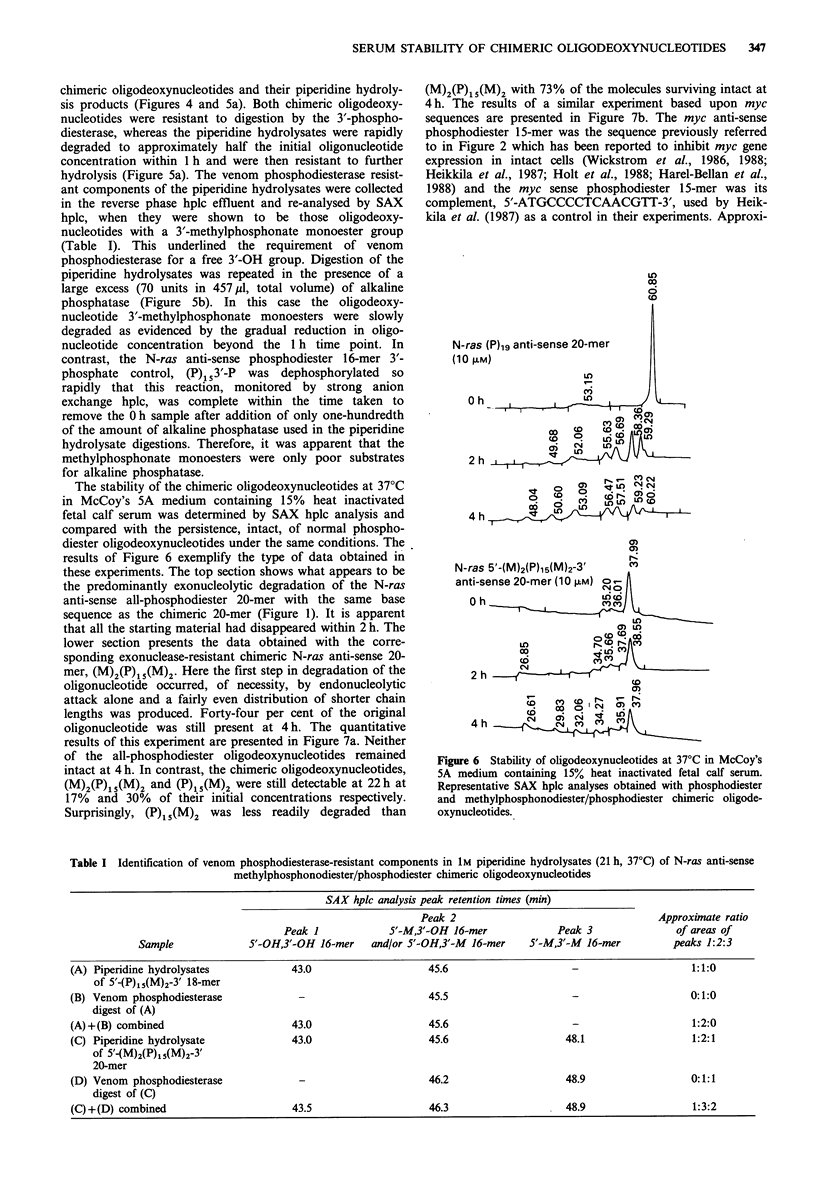Abstract
Under certain circumstances sequence-specific inhibition of gene expression may be achieved in intact cells using exogenous anti-sense oligodeoxynucleotides. The efficacy of this approach to investigating gene function is limited in part by the rapid serum nuclease mediated degradation of oligodeoxynucleotides in culture media. In order to determine the relative contributions of 3'-exonuclease, 5'-exonuclease and endonuclease activity in fetal calf serum to oligodeoxynucleotide destruction, we have tested chimeric N-ras anti-sense sequence molecules protected against exonuclease attack with terminal methylphosphonate diester linkages. An 18-mer with two methylphosphonate diester linkages at the 3'-terminus, a 20-mer with two methylphosphonate diester groups at both ends, and the 16-mer 3'-methylphosphonate monoester components of their respective piperidine hydrolysates were totally resistant to venom phosphodiesterase, whereas the 16-mer 3'-hydroxyl components of the hydrolysates were rapidly degraded. Both the chimeric oligodeoxynucleotides and 3'-methylphosphonate monoesters were considerably more stable than normal 3'-hydroxyl oligodeoxynucleotides at 37 degrees C in McCoy's 5A medium containing 15% heat inactivated fetal calf serum. Typically 20-30% of the former (initial concentration 10-100 microM) remained intact at 20 h as compared to the latter which were 88-100% degraded in 4 h and undetectable at 20 h. We conclude that a 3'-phosphodiesterase activity is a predominant nuclease responsible for oligodeoxynucleotide degradation by fetal calf serum, and that for cell culture studies, significant protection of oligodeoxynucleotides may be achieved by incorporating 3'-terminal methylphosphonate diester or even monoester end groups.
Full text
PDF







Selected References
These references are in PubMed. This may not be the complete list of references from this article.
- Donis-Keller H. Site specific enzymatic cleavage of RNA. Nucleic Acids Res. 1979 Sep 11;7(1):179–192. doi: 10.1093/nar/7.1.179. [DOI] [PMC free article] [PubMed] [Google Scholar]
- Harel-Bellan A., Ferris D. K., Vinocour M., Holt J. T., Farrar W. L. Specific inhibition of c-myc protein biosynthesis using an antisense synthetic deoxy-oligonucleotide in human T lymphocytes. J Immunol. 1988 Apr 1;140(7):2431–2435. [PubMed] [Google Scholar]
- Heikkila R., Schwab G., Wickstrom E., Loke S. L., Pluznik D. H., Watt R., Neckers L. M. A c-myc antisense oligodeoxynucleotide inhibits entry into S phase but not progress from G0 to G1. 1987 Jul 30-Aug 5Nature. 328(6129):445–449. doi: 10.1038/328445a0. [DOI] [PubMed] [Google Scholar]
- Holt J. T., Redner R. L., Nienhuis A. W. An oligomer complementary to c-myc mRNA inhibits proliferation of HL-60 promyelocytic cells and induces differentiation. Mol Cell Biol. 1988 Feb;8(2):963–973. doi: 10.1128/mcb.8.2.963. [DOI] [PMC free article] [PubMed] [Google Scholar]
- Keith G., Gilham P. T. Stepwise degradation of polyribonucleotides. Biochemistry. 1974 Aug 13;13(17):3601–3606. doi: 10.1021/bi00714a031. [DOI] [PubMed] [Google Scholar]
- Maher L. J., 3rd, Dolnick B. J. Comparative hybrid arrest by tandem antisense oligodeoxyribonucleotides or oligodeoxyribonucleoside methylphosphonates in a cell-free system. Nucleic Acids Res. 1988 Apr 25;16(8):3341–3358. doi: 10.1093/nar/16.8.3341. [DOI] [PMC free article] [PubMed] [Google Scholar]
- Miller P. S., Agris C. H., Murakami A., Reddy P. M., Spitz S. A., Ts'o P. O. Preparation of oligodeoxyribonucleoside methylphosphonates on a polystyrene support. Nucleic Acids Res. 1983 Sep 24;11(18):6225–6242. doi: 10.1093/nar/11.18.6225. [DOI] [PMC free article] [PubMed] [Google Scholar]
- Miller P. S., Dreon N., Pulford S. M., McParland K. B. Oligothymidylate analogues having stereoregular, alternating methylphosphonate/phosphodiester backbones. Synthesis and physical studies. J Biol Chem. 1980 Oct 25;255(20):9659–9665. [PubMed] [Google Scholar]
- Miller P. S., McParland K. B., Jayaraman K., Ts'o P. O. Biochemical and biological effects of nonionic nucleic acid methylphosphonates. Biochemistry. 1981 Mar 31;20(7):1874–1880. doi: 10.1021/bi00510a024. [DOI] [PubMed] [Google Scholar]
- Murakami A., Blake K. R., Miller P. S. Characterization of sequence-specific oligodeoxyribonucleoside methylphosphonates and their interaction with rabbit globin mRNA. Biochemistry. 1985 Jul 16;24(15):4041–4046. doi: 10.1021/bi00336a036. [DOI] [PubMed] [Google Scholar]
- Shen W. P., Aldrich T. H., Venta-Perez G., Franza B. R., Jr, Furth M. E. Expression of normal and mutant ras proteins in human acute leukemia. Oncogene. 1987 May;1(2):157–165. [PubMed] [Google Scholar]
- Shibahara S., Mukai S., Nishihara T., Inoue H., Ohtsuka E., Morisawa H. Site-directed cleavage of RNA. Nucleic Acids Res. 1987 Jun 11;15(11):4403–4415. doi: 10.1093/nar/15.11.4403. [DOI] [PMC free article] [PubMed] [Google Scholar]
- Smith C. C., Aurelian L., Reddy M. P., Miller P. S., Ts'o P. O. Antiviral effect of an oligo(nucleoside methylphosphonate) complementary to the splice junction of herpes simplex virus type 1 immediate early pre-mRNAs 4 and 5. Proc Natl Acad Sci U S A. 1986 May;83(9):2787–2791. doi: 10.1073/pnas.83.9.2787. [DOI] [PMC free article] [PubMed] [Google Scholar]
- Tidd D. M., Johnston H. P., Gibson I. Effects of bis(6-mercaptopurine-9-beta-D-ribofuranoside)-5',5"-phosphate and its butyryl derivative on mouse leukaemia L1210 and a 6-mercaptopurine-resistant subline in culture. Biochem Pharmacol. 1982 Sep 15;31(18):2903–2912. doi: 10.1016/0006-2952(82)90262-3. [DOI] [PubMed] [Google Scholar]
- Wickstrom E. L., Bacon T. A., Gonzalez A., Freeman D. L., Lyman G. H., Wickstrom E. Human promyelocytic leukemia HL-60 cell proliferation and c-myc protein expression are inhibited by an antisense pentadecadeoxynucleotide targeted against c-myc mRNA. Proc Natl Acad Sci U S A. 1988 Feb;85(4):1028–1032. doi: 10.1073/pnas.85.4.1028. [DOI] [PMC free article] [PubMed] [Google Scholar]
- Wickstrom E. Oligodeoxynucleotide stability in subcellular extracts and culture media. J Biochem Biophys Methods. 1986 Sep;13(2):97–102. doi: 10.1016/0165-022x(86)90021-7. [DOI] [PubMed] [Google Scholar]
- Zamecnik P. C., Goodchild J., Taguchi Y., Sarin P. S. Inhibition of replication and expression of human T-cell lymphotropic virus type III in cultured cells by exogenous synthetic oligonucleotides complementary to viral RNA. Proc Natl Acad Sci U S A. 1986 Jun;83(12):4143–4146. doi: 10.1073/pnas.83.12.4143. [DOI] [PMC free article] [PubMed] [Google Scholar]
- Zamecnik P. C., Stephenson M. L. Inhibition of Rous sarcoma virus replication and cell transformation by a specific oligodeoxynucleotide. Proc Natl Acad Sci U S A. 1978 Jan;75(1):280–284. doi: 10.1073/pnas.75.1.280. [DOI] [PMC free article] [PubMed] [Google Scholar]


